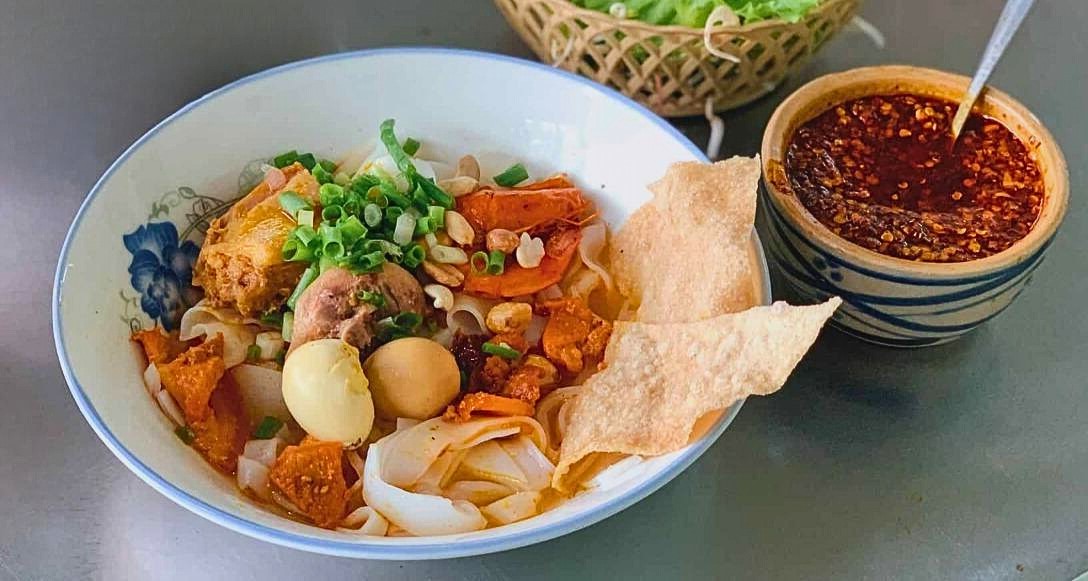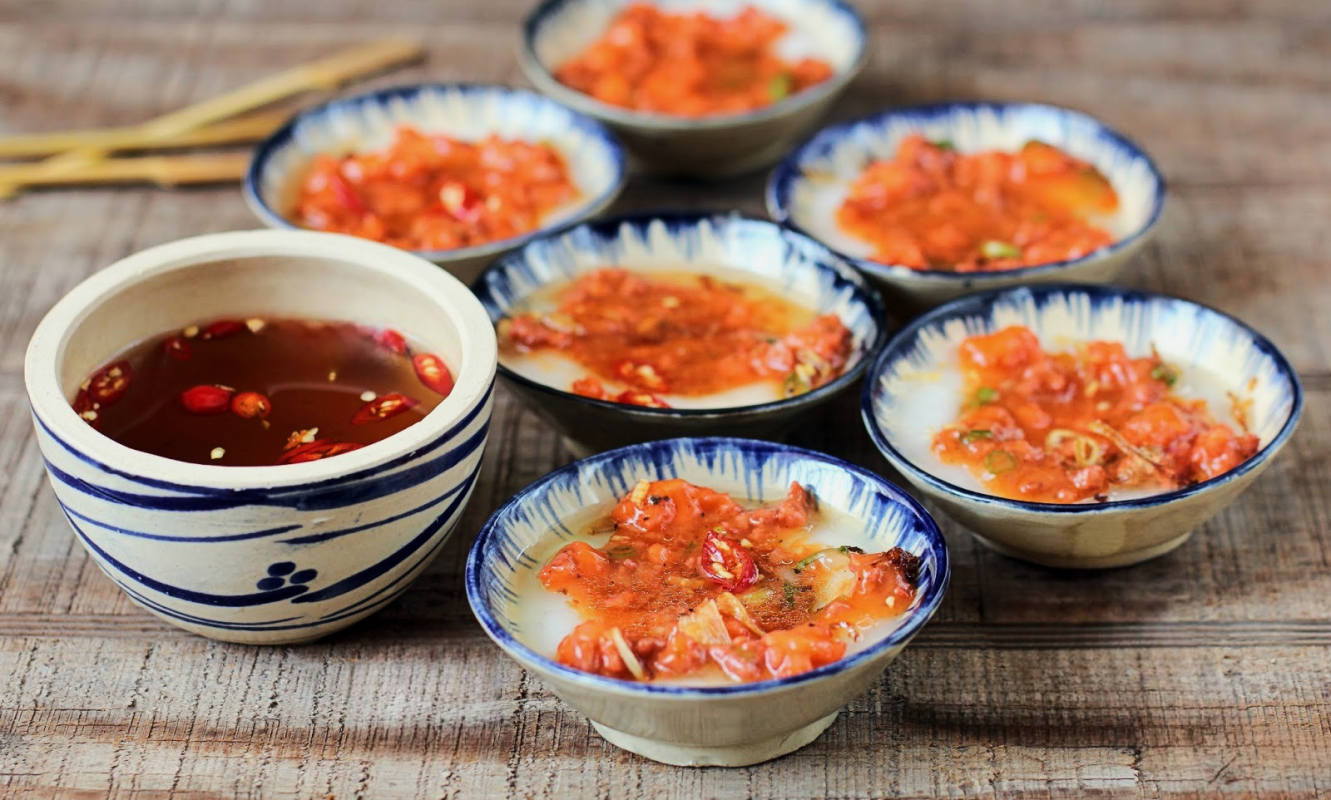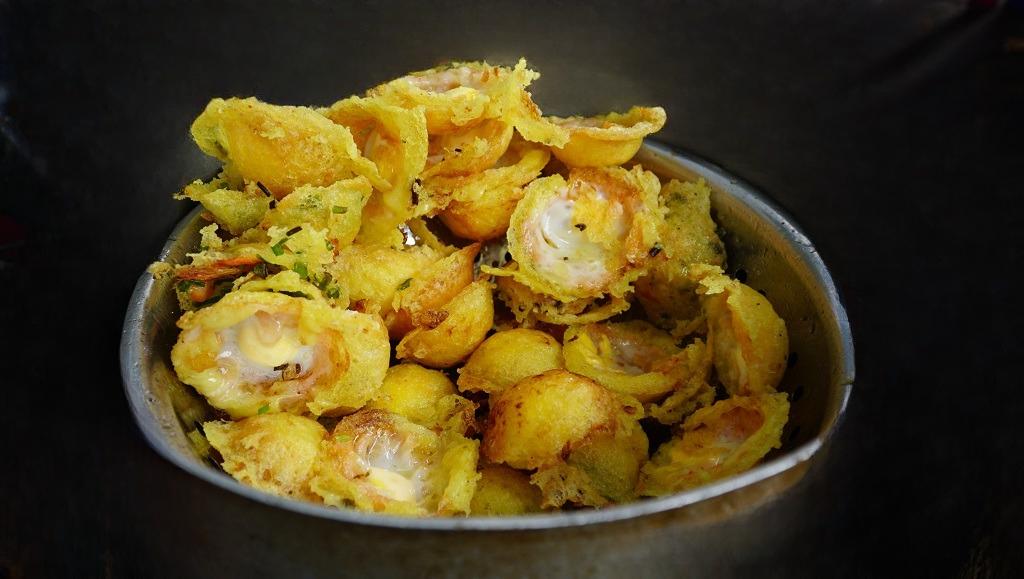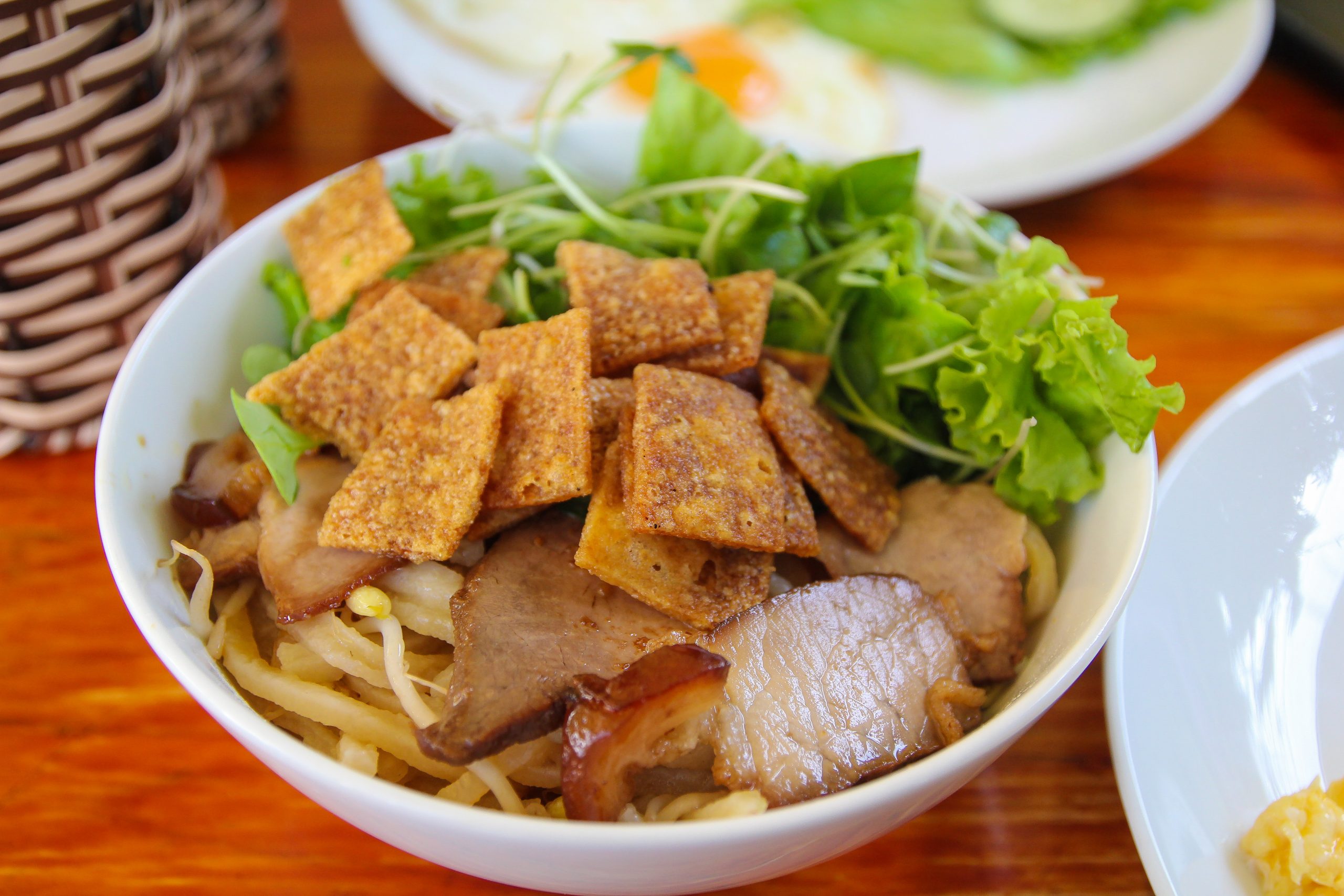Da Nang Food: 10 Uniques Specialties in Da Nang is an article introducing special foods in Da Nang City, which cannot be missed when coming to this city.
Da Nang is a coastal city in Central Vietnam, famous for its stunning beaches, majestic mountains and rich cultural heritage. But in Da Nang is also a foodie’s paradise, with a diverse and delicious cuisine that reflects the city’s history, geography and culture. From noodles to pancake, from rice paper to fish cakes, Da Nang has something for everyone’s taste.
. 1. Mỳ Quảng (Da Nang Signature Noodle Dish)
Mỳ Quảng is a vermicelli dish with originating from Quang Nam province but has become a typical dish of Da Nang. It uses thick rice noodles, often yellow-tinted from turmeric, the noodles are usually wide and flat, topped with various meats, such as pork, chicken, shrimp or fish and fresh herbs, such as basil, mint and cilantro. The broth is made from simmering meat (often pork, chicken or shrimp) with a blend of spices, turmeric and sometimes a bit of tamarind for tanginess.
Mỳ Quảng is typically seasoned with fish sauce, garlic and sometimes a touch of sugar. Lime wedges and sliced chili peppers are often served on the side, allowing diners to adjust the flavor to their liking.
.

2. Bánh Tráng Cuốn Thịt Heo (Fresh Spring Rolls with Pork)
Bánh Tráng Cuốn Thịt Heo is a dish made with rice paper, boiled pork, fresh vegetables and herbs. The pork is usually boiled and cut into thinly sliced served with the vegetables and herbs include lettuce, cucumber, carrots, bean sprouts, mint and perilla.
Bánh Tráng Cuốn Thịt Heo is unique from other spring rolls because it is served with a dipping sauce called “Mắm Nêm”, a fermented fish sauce. The fish sauce is mixed with sugar, chili, garlic, lemongrass, and pineapple to achieve its deliciously sweet and sour taste.

3. Bánh bèo in Da Nang City (Contrasting styles)
Bánh Bèo is a steamed cake, served with dried shrimp, pork skin, green onions and delicious dipping sauce. This is a popular snack in the Central region, especially Da Nang and Hue. However, Bánh Bèo in Da Nang is quite different from Bánh Bèo in Hue in both preparation and flavor.
Bánh Bèo in Da Nang is usually bigger and thicker than Bánh Bèo in Hue and is served on a separate plate instead of on a large tray. Bánh Bèo is also softer and smoother, the filling is also richer and more diverse. The dipping sauce is also richer and sweeter and is poured over the Bánh Bèo instead of served separately.

4. Bún Chả Cá (Da Nang Fish Cake Noodle Soup)
Bún Chả Cá is a flavorful and aromatic noodle soup from Da Nang, a coastal city in Central Vietnam. Bún Chả Cá features vermicelli served in a clear, fragrant broth.
The broth is often made from simmering fish bones, which impacts a rich and delicate flavor. And a standout ingredient in this dish is the fish cakes. These are usually made from minced fish mixed with spices and herbs, then formed into patties or chunks and either fried or steamed.
Bún Chả Cá is often served with a side of pickled vegetables, lime wedges, and chili peppers, allowing diners to adjust the flavor to their liking.
The soup is garnished with fresh herbs such as cilantro and green onions, along with vegetables like tomatoes and daikon radish. These add freshness and texture to the dish.

5. Bún Mắm (Fermented Fish Noodle Soup)
Bún Mắm is a noodle dish with a special fermented fish broth, which gives the dish a rich and spicy flavor. It originated in the Mekong Delta but has also become popular in Da Nang. It is usually eaten for lunch or dinner and is often served with fresh vegetables, herbs and fruits.
Bún Mắm consists of rice noodles, topped with various meats such as pork belly, shrimp or fish cake. It is often served with a plentiful platter of crunchy vegetables and Vietnamese herbs, limes and fresh chilies. The broth is murky, salty and flavored with the granddaddy of all Vietnamese condiments, fermented fish is made from fermented fish sauce (Mắm), a condiment made from fish, salt and water, fermented for months or years.
The broth is also seasoned with sugar, tamarind, garlic and chili and boiled with pork bones, dried shrimp and lemongrass. The dish is often garnished with fresh herbs such as coriander, mint and basil and served with lime, chili sauce and fish sauce.

6. Bánh Căn (Miniature Rice Pancakes)
Bánh Căn is a dish consisting of small pancakes, baked in small clay, molds over charcoal. It is often eaten as a snack and is accompanied by a sweet and sour fish sauce with minced chili and garlic.
Bánh Căn is a small, crispy and spongy round dish. The dough is made from rice flour, water, coconut milk and turmeric, which gives the cake its yellow color. The cake is also stuffed with various toppings, such as shrimp, pork and quail eggs. The cake is baked until golden and crispy, then flipped over and baked again.
Bánh Căn is a dish with many toppings, spices and variations, depending on local preferences.

7. Bánh Đập (Crispy Rice Paper)
Bánh Đập is a dish originating from Quang Nam province but has also become popular in Da Nang. It is often eaten as a snack or side dish and is often served with grilled or fried seafood such as squid, shrimp or fish.
Bánh Đập is a dish with a special texture because it combines the crunchiness of crispy rice paper and the softness of wet rice paper. The dipping sauce is also an important part of the dish, as it adds flavor and balance to the rice paper. The dipping sauce should have enough sweet, sour, salty and spicy flavors, with a little garlic and chili.
To eat Bánh Đập, you need to use your hands and a little force. First, you take a piece of rice paper and place it on a plate. Then, use your palm or fist to hit it until it breaks into smaller pieces. Next, you dip it in the dipping sauce and enjoy the crunchy, chewy feeling in your mouth

8. Bánh Xèo and Nem Lụi (Crispy Pancakes and Lemongrass Skewers)
Bánh Xèo and Nem Lụi are two dishes that are often eaten together in Da Nang because they complement each other so well. Bánh Xèo is a crispy pancake made from rice flour, water, turmeric powder and coconut milk, fried in a large pan, filled with pork, shrimp, bean sprouts and green onions. Nem Lụi is a lemongrass skewer, made from minced pork mixed with garlic, sugar, fish sauce and lemongrass, shaped into a cylinder and grilled over charcoal.
Bánh Xèo And Nem Lụi are delicious and nutritious dishes that can be eaten as a snack or a main meal. The pancake is crispy and golden, while the filling is fragrant and juicy. The meat on the skewer is fragrant and tender, while the lemongrass adds a fresh and citrus flavor. The dishes are often served with fresh herbs such as mint, basil, lettuce and a dipping sauce made from fish sauce, sugar, lime juice, garlic and chili.

9. Cao Lầu (Traditional noodle dish)
Cao Lầu is a noodle dish with thick and chewy noodles, topped with thinly sliced pork, bean sprouts, herbs and crispy rice paper. This is a traditional dish of Hoi An, recognized by the Asian Record Organization as one of the 10 dishes with Asian culinary value.
Cao Lầu is a dish that combines many flavors, combining the sweet and salty taste of pork, the crunchiness of rice paper, the fresh aroma of herbs and the spicy taste of rice paper. Dipping sauce. The dipping sauce is made from soy sauce, sugar, vinegar, garlic, chili and is poured over the noodles rather than used as a broth. The noodles are made from rice flour, mixed with the ash of a local tree called Cu Lao Cham, giving the noodles a yellow color and firm texture. The water used to cook the noodles is also taken from a special well in Hoi An called Gieng Ba Le, which is said to have special mineral composition. The pork is marinated with spices such as star anise, cinnamon, cardamom and then grilled over charcoal. The rice paper is also homemade and fried until puffy and crispy

10. Kem Bơ ( Buttercream)
If you are looking for a delicious and refreshing dessert, try Da Nang Kem Bơ, a local dessert of Da Nang city. Kem Bơ means “buttercream” but it is not actually made from avocado. Kem Bơ is a combination of vanilla ice cream, fresh avocado and toasted coconut. Cream and avocado are mixed to create a unique flavor and texture, adding shredded coconut to enhance the flavor and aroma. The result is a rich, smooth and delicious dish that melts in your mouth.
Kem bơ quickly became popular with diners, especially students and young people. Since then, Kem Bơ has become a typical dessert of Da Nang city.





